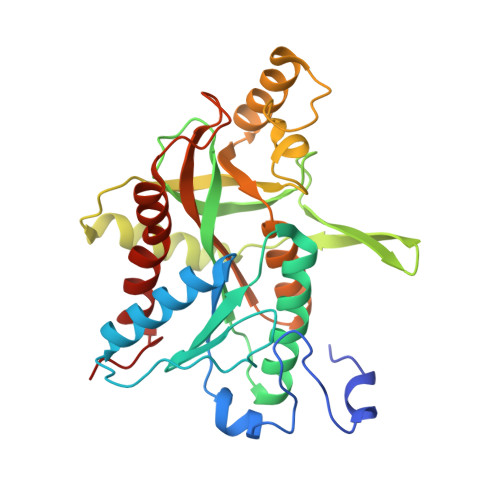Analysis of two Schistosoma mansoni uridine phosphorylases isoforms suggests the emergence of a protein with a non-canonical function.
da Silva Neto, A.M., Torini de Souza, J.R., Romanello, L., Cassago, A., Serrao, V.H., DeMarco, R., Brandao-Neto, J., Garratt, R.C., Pereira, H.D.(2016) Biochimie 125: 12-22
- PubMed: 26898674
- DOI: https://doi.org/10.1016/j.biochi.2016.02.007
- Primary Citation of Related Structures:
4TXH, 4TXJ, 4TXL, 4TXM, 4TXN, 5CYF, 5CYG - PubMed Abstract:
Reports of Schistosoma mansoni strains resistant to praziquantel, the only therapeutic strategy available for the treatment of schistosomiasis, have motivated the scientific community towards the search for new possible therapies. Biochemical characterization of the parasite's metabolism is an essential component for the rational development of new therapeutic alternatives. One of the so far uncharacterized enzymes is uridine phosphorylase (UP) (EC 2.4.2.3), for which the parasite genome presents two isoforms (SmUPa and SmUPb) that share 92% sequence identity. In this paper, we present crystal structures for SmUPa and SmUPb in their free states as well as bound to different ligands. This we have complemented by enzyme kinetic characterization and phylogenetic analyses. Both enzymes present an overall fold and active site structure similar to other known UPs. The kinetic analyses showed conclusively that SmUPa is a regular uridine phosphorylase but by contrast SmUPb presented no detectable activity. This is particularly noteworthy given the high level of sequence identity between the two isoforms and is probably the result of the significant differences observed for SmUPb in the vicinity of the active site itself, suggesting that it is not a UP at all. On the other hand, it was not possible to identify an alternative function for SmUPb, although our phylogenetic analyses and expression data suggest that SmUPb is still functional and plays a role in parasite metabolism. The unusual UPb isoform may open up new opportunities for understanding unique features of S. mansoni metabolism.
Organizational Affiliation:
São Carlos Institute of Physics, São Paulo University, São Carlos, São Paulo, Brazil.
















